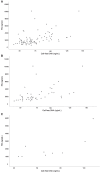Increased cell-free DNA in CSF and serum of hip fracture patients with delirium
- PMID: 39737468
- PMCID: PMC11683831
- DOI: 10.1093/braincomms/fcae452
Increased cell-free DNA in CSF and serum of hip fracture patients with delirium
Abstract
Delirium is a neuropsychiatric syndrome commonly presenting during acute illness. The pathophysiology of delirium is unknown, but neuroinflammation is suggested to play a role. In this cross-sectional study, we aimed to investigate whether cell-free DNA and markers of neutrophil extracellular traps in serum and CSF were associated with delirium and neuronal damage, assessed by neurofilament light chain. Hip fracture patients (n = 491) with a median (25, 75 percentiles) age of 83 (74, 88) years and 69% females were enrolled at Oslo University Hospital, Diakonhjemmet Hospital, Akershus University Hospital and Bærum Hospital. Delirium was assessed daily, pre- and postoperatively. Cognitively healthy adults (n = 32) with a median (25, 75 percentiles) age of 75 (70, 77) years and 53% females were included as controls. Cell-free DNA was measured by using the fluorescent nucleic acid stain Quant-iT PicoGreen® in serum and CSF. Myeloperoxidase-DNA and citrullinated histone H3 were analysed by enzyme-linked immunosorbent assay in serum. Hip fracture patients have significantly higher levels of cell-free DNA and neutrophil extracellular traps in blood than cognitively healthy controls. In hip fracture patients without dementia, cell-free DNA in CSF and serum was significantly higher in patients with (n = 68) versus without (n = 221) delirium after adjusting for age and sex (70 (59, 84) versus 62 (53, 77) ng/ml, P = 0.037) and 601 (504, 684) versus 508 (458, 572) ng/ml, P = 0.007, respectively). In the total hip fracture cohort, CSF levels of cell-free DNA and neurofilament light chain were significantly correlated after adjusting for age and sex (r = 0.441, P < 0.001). The correlation was stronger in those with delirium (r = 0.468, P < 0.001) and strongest in delirious patients without dementia (r = 0.765, P = 0.045). In delirious patients without dementia, significantly higher levels of cell-free DNA in CSF and serum were shown. The association between cell-free DNA and neurofilament light chain suggest simultaneous release of cell-free DNA and neuronal damage during delirium.
Keywords: cell-free DNA; delirium; neurofilament light chain; neuroinflammation; neutrophil extracellular traps.
© The Author(s) 2024. Published by Oxford University Press on behalf of the Guarantors of Brain.
Conflict of interest statement
H.Z. has served at scientific advisory boards and/or as a consultant for AbbVie, Acumen, Alector, Alzinova, ALZPath, Annexon, Apellis, Artery Therapeutics, AZTherapies, CogRx, Denali, Eisai, Nervgen, Novo Nordisk, Optoceutics, Passage Bio, Pinteon Therapeutics, Prothena, Red Abbey Labs, reMYND, Roche, Samumed, Siemens Healthineers, Triplet Therapeutics, and Wave, has given lectures in symposia sponsored by Cellectricon, Fujirebio, Alzecure, Biogen, and Roche, and is a co-founder of Brain Biomarker Solutions in Gothenburg AB (BBS), which is a part of the GU Ventures Incubator Program (outside submitted work). The other authors declared no potential conflicts of interest with respect to the research, authorship, and/or publication of this article.
Figures





Similar articles
-
Neurofilament Light in Serum and Cerebrospinal Fluid of Hip Fracture Patients with Delirium.Dement Geriatr Cogn Disord. 2018;46(5-6):346-357. doi: 10.1159/000494754. Epub 2018 Dec 6. Dement Geriatr Cogn Disord. 2018. PMID: 30522125
-
Increased CSF levels of aromatic amino acids in hip fracture patients with delirium suggests higher monoaminergic activity.BMC Geriatr. 2016 Aug 2;16:149. doi: 10.1186/s12877-016-0324-0. BMC Geriatr. 2016. PMID: 27484129 Free PMC article.
-
Fatty Acid-Binding Protein 3 in Cerebrospinal Fluid of Hip Fracture Patients with Delirium.J Alzheimers Dis. 2020;77(1):183-190. doi: 10.3233/JAD-200364. J Alzheimers Dis. 2020. PMID: 32804136
-
Cerebrospinal Fluid Levels of Interleukin-8 in Delirium, Dementia, and Cognitively Healthy Patients.J Alzheimers Dis. 2020;73(4):1363-1372. doi: 10.3233/JAD-190941. J Alzheimers Dis. 2020. PMID: 31929159
-
Neuraxial versus general anesthesia in elderly patients undergoing hip fracture surgery and the incidence of postoperative delirium: a systematic review and stratified meta-analysis.BMC Anesthesiol. 2023 Jul 22;23(1):250. doi: 10.1186/s12871-023-02196-9. BMC Anesthesiol. 2023. PMID: 37481517 Free PMC article.
References
-
- Witlox J, Eurelings LS, de Jonghe JF, Kalisvaart KJ, Eikelenboom P, van Gool WA. Delirium in elderly patients and the risk of postdischarge mortality, institutionalization, and dementia: A meta-analysis. JAMA. 2010;304(4):443–451. - PubMed
LinkOut - more resources
Full Text Sources
Research Materials
